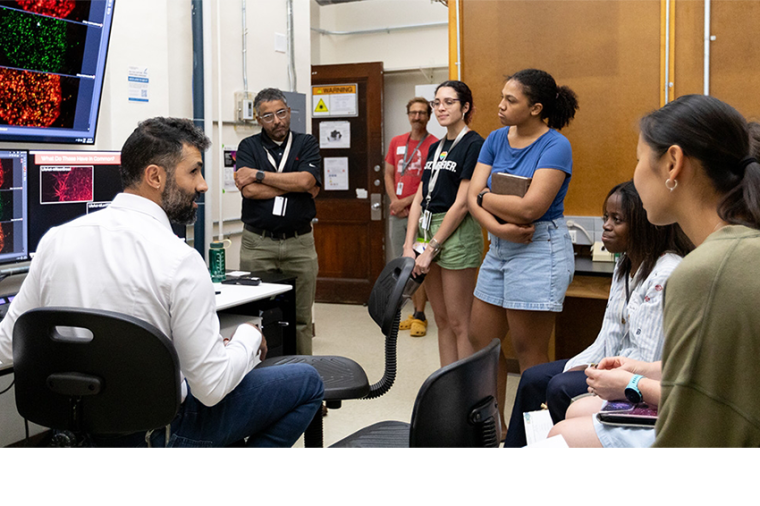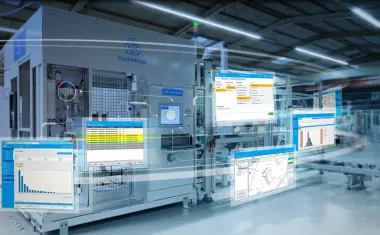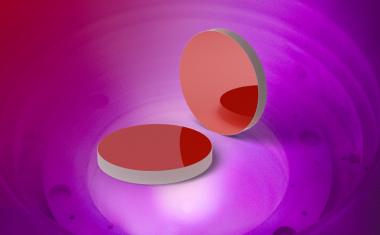New microscopes available as public resource draw a crowd to Woods Hole
Two advanced microscopes at the Marine Biological Laboratory were presented at an Open House
Nearly a hundred people, a mix of scientists, vendors and curious onlookers, attended an Open House for two new microscopes at the Marine Biological Laboratory (MBL) on June 26. These new, eye-popping microscopes for biological and biomedical research were funded by a 4.3 million dollars award from the Massachusetts Life Sciences Center (MLSC) to the MBL. They provide a valuable and rare resource not only for Woods Hole scientists and students, but for researchers across the state who wish to use them. One of the microscopes, an advanced electron microscope, is the only one of its type available in Massachusetts for public use.

“One of the long-held traditions of the MBL is excellence in imaging,” said MBL director Nipam Patel in the event’s introductory session. “We hope to stay at the forefront of imaging not only by designing our own instruments in-house, but by staying on the cutting edge of what’s commercially available and making sure we have the expertise to take advantage of it. Our thanks to the MLSC and the microscope vendors here today for furthering that mission.”
The new instruments are complementary: a light microscope manufactured by Leica, the Stellaris 8 STED; and an electron microscope by Thermo Fisher Scientific, the PFIB-SEM Helios 5 Hydra. “The crux of our MLSC proposal was the idea that you could do correlative imaging with these two instruments,” said MBL director of imaging services Louis Kerr. “We can use them to image the same or similar samples and hopefully confirm the results in different ways.”
A big advantage of the new light microscope, the Leica Stellaris 8 STED, is its white-light laser, according to Kerr and MBL associate director of imaging services Carsten Wolff. In fluorescence microscopy, the molecules the scientist wants to “see” are labeled with a fluorophore, such as green fluorescent protein (GFP), which gets excited at a particular wavelength. When the microscope’s laser hits the fluorophores, they absorb light of short wavelength and emit light of longer wavelength. Sensitive light detectors in the microscope can thus image the location of the fluorescently labeled molecules.
“We do a lot of multiplexing at MBL, where we put several different fluorophores in one sample,” Wolff said. “The Leica white-light laser – with a wavelength range from 450 nm to 790 nm – can produce up to eight different wavelengths simultaneously, so we can potentially have tendifferent labels in one sample, or even more,” he said.
The Leica is also equipped for fluorescence lifetime imaging microscopy (FLIM), “which continues to gain interest in biology; it used to be primarily used by biophysicists,” Wolff said. With FLIM, scientists can capture extremely small changes in the local environment around the molecules being imaged, such as the cell membrane. For example, a change in pH can be detected because it changes how fast or slow the fluorophores emit light, which the microscope measures. “We are already getting requests from the MBL Physiology and Embryology courses to do FLIM,” said Wolff.
Patel and MBL Director of Research Anne Sylvester emphasized that these advanced instruments couldn’t be deployed without the technical expertise provided by the vendors. They thanked Leica representatives Manjot Deol, Haridas Pudavar and Louise Bertrand, and Thermo Fisher Scientific representative Geoff Perumal, for investing hours into training MBL scientists. Sylvester also acknowledged the guidance of Rosalee Maffitt, program manager for industry strategy and investments at the Massachusetts Life Sciences Center.











